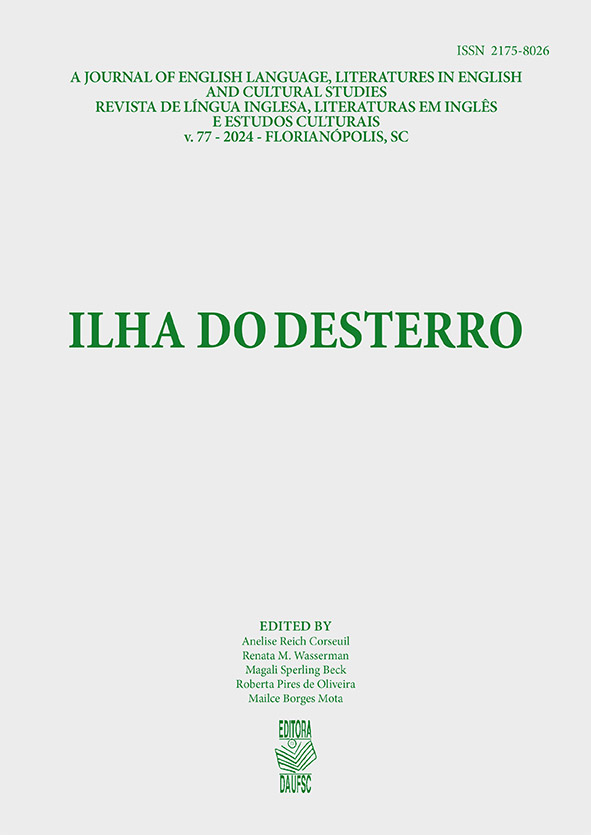Gothic entrapment within textuality in Auster’s travels in the scriptorium
DOI:
https://doi.org/10.5007/2175-8026.2024.e98774Palavras-chave:
Gothic-Postmodernism, Textuality, Sublime, Travels in the Scriptorium, UncannyResumo
“Gothic-postmodernism” builds upon the shared ontological inquiry into the nature of reality inherent in both the Gothic and postmodernism. By adapting most of the thematic and narrative elements of the Gothic to postmodernist fiction, this genre enables new interpretations of self-reflective literature, where the Gothic sublime manifests itself through textual erasure as Gothic-postmodernist horror. This article argues that Travels in the Scriptorium is Auster’s significant contribution to Gothic-postmodernism, given its self-reflexivity as postmodernist metafiction and its Gothic aspirations in merging Gothic conventions with postmodern techniques. In Auster’s exhaustive metafiction, postmodernism plays a pivotal role in the text’s sublimity and the resultant horror of textuality, which creates a profound sense of awe and fear. This is achieved through the text’s exploration of reality’s fragmented nature, the manipulation of narrative form, and the meta-awareness of its own fictionality. These elements collectively create a sense of awe and terror, challenging the representation of fictional truth through the very medium of language.
Referências
Anderson, Pamela Sue. “Sublime.” The Lyotard Dictionary, edited by Stuart Sim. Edinburgh UP, 2011, pp. 217-219.
Auster, Paul. Travels in the Scriptorium. Faber and Faber, 2006.
Barthes, Roland. “The Death of the Author.” Image Music Text, translated by Stephen Heath. Hill and Wang, 1977, pp. 142–148.
Bennett, Andrew, and Nicholas Royle. Introduction to Literature, Criticism and Theory, 4th ed. Routledge, 2009.
Bernstein, Stephen. “Auster’s Sublime Closure: The Locked Room.” Beyond the Red Notebook: Essays on Paul Auster, edited by Dennis Barone. U of Pennsylvania P, 1995, pp. 88-106.
Beville, Maria. “A. S. Byatt’s ‘The Dried Witch’ (1987) – Postmodern Gothic.” The Gothic: A Reader, edited by Simon Bacon. Peter Lang, 2022, pp. 145-150.
Beville, Maria. Gothic-Postmodernism: Voicing the Terrors of Postmodernity. Rodopi, 2009.
Botting, Fred. Gothic. Routledge, 2005.
Botting, Fred. “Horror”. The Handbook of the Gothic. 2nd ed., edited by Marie Mulvey-Roberts. Palgrave Macmillan, 2009, pp. 184-192.
Boulter, Jonathan. Melancholy and the Archive: Trauma, Memory, and History in the Contemporary Novel. Continuum, 2011.
Burke, Edmund. A Philosophical Enquiry into the Sublime and the Beautiful. 1757. Penguin, 1998.
Butler, Martin, and Jens Martin Gurr. “Poetics and Politics of Metafiction: Reading Paul Auster's Travels in the Scriptorium.” English Studies, vol. 89, no. 2, 2008, pp. 195-209. https://doi.org/10.1080/00138380801912883
Calvino, Italo. If on a winter's night a traveler. Harcourt Brace Jovanovich, 1979.
“Echolalia.” Merriam-Webster.com Dictionary, Merriam-Webster, https://www.merriam-webster.com/dictionary/echolalia. Accessed 30 Nov. 2024.
“Echopraxia.” Merriam-Webster.com Medical Dictionary, Merriam-Webster, https://www.merriam-webster.com/medical/echopraxia. Accessed 30 Nov. 2024.
Fowles, John. The French Lieutenant's Woman. Jonathan Cape, 1969.
Galens, David, editor. Literary Movements for Students, Volume 1. Thomson Gale, 2002.
Ganos, Christos, et al. “The Pathophysiology of Echopraxia/Echolalia: Relevance to Gilles de la Tourette Syndrome.” Movement Disorders, vol. 27, no. 10, Sep. 2012, pp. 1222–9. https://doi.org/10.1002/mds.25103
Gass, William H. Fiction and the Figures of Life. Alfred A. Knopf, 1970.
Fludernik, Monika. Metaphors of Confinement: The Prison in Fact, Fiction, and Fantasy. Oxford UP, 2019.
Freud, Sigmund. “The Uncanny”. The Standard Edition of the Complete Psychological Works of Sigmund Freud. Vol. 17 (1917-1919), An Infantile Neurosis and Other Works, translated by James Strachey et al. Vantage, 1981, pp. 219-252.
Hughes, William. Key Concepts in the Gothic. Edinburgh UP, 2018.
Hume, Robert, D. “Gothic Versus Romantic: A Reevaluation or the Gothic Novel.” PMLA, vol. 84, Mar. 1969, pp. 282-90. https://doi.org/10.2307/1261285
Hutchisson, James M., editor. Conversation with Paul Auster. UP of Mississippi, 2013.
Jackson, Shirley. The Haunting of Hill House. Viking Press, 1959.
James, Henry. The Turn of the Screw. Macmillan, 1898.
Lyotard, Jean-François. The Postmodern Condition: A Report on Knowledge. Translated by Geoffrey Bennington and Brian Massumi, 1979. U of Minnesota P, 1984.
Lyotard, Jean-François. “The Sublime and the Avant-Garde.” Artforum, vol. 22, no. 8, April 1984, pp. 64-69.
Macandrew, Elizabeth. The Gothic Tradition in Fiction. Columbia UP, 1979.
McHale, Brian. Postmodernist Fiction. Routledge, 1987.
McRobert, Neil. “Figuring the Author in Modern Gothic Writing”. The Gothic World, edited by Glennis Byron and Dale Townshend. Routledge, 2014, pp. 297-397.
Milbank, Alison. “The Sublime.” The Handbook of the Gothic. 2nd ed., edited by Marie Mulvey-Roberts. Palgrave Macmillan, 2009, pp. 235-240.
Miles, Roberts. Gothic Writing, 1750–1820: A Genealogy. Manchester UP, 1993.
Nietzsche, Friedrich Wilhelm. Will to Power. Translated by Walter Kaufmann and R. J. Hollingdale, 1901. Vintage Books, 1986.
Punter, David. “Terror”. The Handbook of the Gothic. 2nd ed., edited by Marie Mulvey-Roberts. Palgrave Macmillan, 2009, pp. 243-249.
Punter, David. “The Uncanny.” The Routledge Companion to Gothic, edited by Catherine Spooner and Emma McEvoypp. Routledge, 2007, pp. 129-136.
Royle, Nicholas. The Uncanny. Manchester UP, 2003.
Rupprecht, Caroline. Womb Fantasies: Subjective Architectures in Postmodern Literature, Cinema, and Art. Northwestern UP, 2013.
Sedgwick, Eve Kosofsky. The Coherence of Gothic Conventions. Methuen, 1986.
Shelley, Mary. Frankenstein; or, The Modern Prometheus. Lackington, Hughes, Harding, Mavor & Jones, 1818.
Smith, Andrew. Gothic Literature. 2nd ed., Edinburgh UP, 2013.
Stoker, Bram. Dracula. Archibald Constable and Company, 1897.
Stones, Alison (2014). “Scriptorium: The Term and Its History.” Perspective, no. 1, 2014, pp. 113–20. https://doi.org/10.4000/perspective.4401
Truffin, Sherry R. “Creation Anxiety in Gothic Metafiction: The Dark Half and The Lunar Park.” A Companion to American Gothic, edited by Charles L. Crow. Wiley Blackwell, 2014, pp. 56-67.
Varvogli, Aliki. The World that Is the Book: Paul Auster’s Fiction. Liverpool UP, 2001.
Waugh, Patricia. Metafiction: The Theory and Practice of Self-Conscious Fiction. Routledge, 1984.
Downloads
Publicado
Licença
Copyright (c) 2023 Mohammad-Javad Haj'jari

Este trabalho está licenciado sob uma licença Creative Commons Attribution 4.0 International License.
A revista Ilha do Desterro publica artigos e resenhas inéditos, referentes as áreas de Inglês, Literaturas em Língua Inglesa e Estudos Culturais. Publica volumes mistos e/ou temáticos, com artigos e resenhas em inglês e português.
Autores mantém os direitos autorais e concedem à revista o direito de primeira publicação, com o trabalho simultaneamente licenciado sob a Licença Creative Commons Attribution que permite o compartilhamento do trabalho com reconhecimento da autoria e publicação inicial nesta revista.

This work is licensed under a Creative Commons Attribution 4.0 International License.



